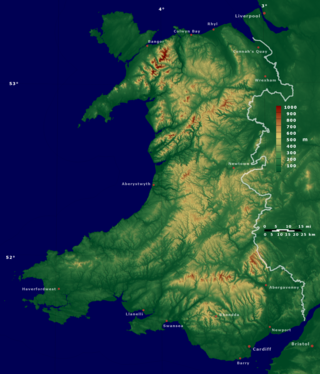
Wales is a country that is part of the United Kingdom. It is bordered by the Irish Sea to the north and west, England to the east, the Bristol Channel to the south, and the Celtic Sea to the south-west. As of the 2021 census, it had a population of 3,107,494. It has a total area of 21,218 square kilometres (8,192 sq mi) and over 2,700 kilometres (1,680 mi) of coastline. It is largely mountainous with its higher peaks in the north and central areas, including Snowdon, its highest summit. The country lies within the north temperate zone and has a changeable, maritime climate. The capital and largest city is Cardiff.

Cambria is a name for Wales, being the Latinised form of the Welsh name for the country, Cymru. The term was not in use during the Roman or the early medieval period. After the Anglo-Saxon settlement of much of Britain, a territorial distinction developed between the new Anglo-Saxon kingdoms and the remaining Celtic British kingdoms. Latin being the primary language of scholarship in Western Christendom, medieval writers commonly used either the older term Britannia, as the territory still inhabited by Britons, or Wallia, a term derived from Old English, to refer to Wales. The term Cambria is first attested in Geoffrey of Monmouth in the 12th century as an alternative to both of these, since Britannia was now ambiguous and Wallia a foreign import, but remained rare until late in the Middle Ages.

Madoc ab Owain Gwynedd was, according to folklore, a Welsh prince who sailed to the Americas in 1170, over three hundred years before Christopher Columbus's voyage in 1492.

Welsh Americans are an American ethnic group whose ancestry originates wholly or partly in Wales, United Kingdom. In the 2008 U.S. Census community survey, an estimated 1.98 million Americans had Welsh ancestry, 0.6% of the total U.S. population. This compares with a population of 3 million in Wales. However, 3.8% of Americans appear to bear a Welsh surname.
William Wynne was a Welsh historian.

The FAW Welsh Trophy is a knock-out football competition contested annually by teams from Wales and the borders.
William Maurice (1620–1680) was a well-known seventeenth-century collector and transcriber of Welsh manuscripts and books from Denbighshire, Wales.
The 1899–1900 Welsh Amateur Cup was the tenth season of the Welsh Amateur Cup. The cup was won by Wellington St. Georges United who defeated Llanrwst Town 2–0 in the final, at Flint.
The 1900–01 Welsh Amateur Cup was the eleventh season of the Welsh Amateur Cup. The cup was won by Wrexham Victoria who defeated Singleton & Coles 1–0 in the final, at The Racecourse, Wrexham.
The 1902–03 Welsh Amateur Cup was the thirteenth season of the Welsh Amateur Cup. The cup was won by Druids Reserves who defeated Bangor Reserves 4–0 in the final, at The Racecourse, Wrexham.
The 1903–04 Welsh Amateur Cup was the fourteenth season of the Welsh Amateur Cup. The cup was won by Wrexham Victoria who defeated Druids Reserves 4–2 in the final, at Oswestry.
The 1904–05 Welsh Amateur Cup was the fifteenth season of the Welsh Amateur Cup. The cup was won by Esclusham White Stars who defeated Bangor Reserves 4–0 in the final, at Wrexham.
The 1908–09 Welsh Amateur Cup was the nineteenth season of the Welsh Amateur Cup. The cup was won by Carnarvon United who defeated Oak Alyn Rovers 5–1 in the final at Colwyn Bay.
The 1909–10 Welsh Amateur Cup was the 20th season of the Welsh Amateur Cup. The cup was won by Johnstown Amateurs who defeated Bangor Reserves 2–1 in the final at Sealand Road, Chester.
The 1910–11 Welsh Amateur Cup was the 21st season of the Welsh Amateur Cup. The cup was won by Buckley Engineers who defeated Aberystwyth 1–0 in the final at Newtown.
The 1905–06 Welsh Amateur Cup was the sixteenth season of the Welsh Amateur Cup. The cup was won by Buckley Engineers who defeated Porthmadog 3–1 in a replayed final, at Welshpool.
The 1906–07 Welsh Amateur Cup was the seventeenth season of the Welsh Amateur Cup. The cup was won by Buckley Engineers who defeated Aberystwyth 2–1 in a replayed final at Newtown.

This is a bibliography of published works on the history of Wales. It includes published books, journals, and educational and academic history-related websites; it does not include self-published works, blogs or user-edited sites. Works may cover aspects of Welsh history inclusively or exclusively.
Alwyn David Rees (1911-1974) was a Welsh geographer, social anthropologist and Welsh nationalist, who wrote as Alwyn D. Rees. After studying geography and anthropology at the University College of Wales, Aberystwyth, he was a tutor in the College's External Department from 1936 to 1946. He was a lecturer in the Department of Geography and Anthropology until 1949, when he was appointed Director of the External Studies Department. Rees pioneered the rural sociology of Britain with Life in a Welsh countryside (1950), a community study of the Welsh village of Llanfihangel yng Ngwynfa. From 1966 until his death he edited the Welsh magazine Barn.





